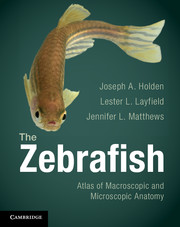Book contents
- Frontmatter
- Contents
- Preface
- Acknowledgments
- Chapter 1 Introduction
- Chapter 2 Cross section and longitudinal section atlas
- Chapter 3 Integument (skin)
- Chapter 4 Digestive system
- Chapter 5 Respiratory system
- Chapter 6 Circulatory system
- Chapter 7 Liver and gallbladder
- Chapter 8 Pancreas
- Chapter 9 Endocrine organs
- Chapter 10 Kidney
- Chapter 11 Reproductive system
- Chapter 12 Sensory systems
- Chapter 13 Central nervous system
- Chapter 14 Miscellaneous structures
- Chapter 15 Musculoskeletal system
- Index
- References
Chapter 7 - Liver and gallbladder
Published online by Cambridge University Press: 05 February 2013
- Frontmatter
- Contents
- Preface
- Acknowledgments
- Chapter 1 Introduction
- Chapter 2 Cross section and longitudinal section atlas
- Chapter 3 Integument (skin)
- Chapter 4 Digestive system
- Chapter 5 Respiratory system
- Chapter 6 Circulatory system
- Chapter 7 Liver and gallbladder
- Chapter 8 Pancreas
- Chapter 9 Endocrine organs
- Chapter 10 Kidney
- Chapter 11 Reproductive system
- Chapter 12 Sensory systems
- Chapter 13 Central nervous system
- Chapter 14 Miscellaneous structures
- Chapter 15 Musculoskeletal system
- Index
- References
Summary
Liver
The liver forms as an evagination from the developing intestine. It lies ventral to the esophagus and intestinal bulb–3. It is not a discrete organ as it is in mammals but rather fills the abdominal cavity as a large U-shaped structure (Figure 7.1), surrounding the intestine. The liver is intimately associated with pancreatic tissue and the gallbladder,. Blood flow to the liver is similar to that in mammals. Blood enters the liver from the portal vein and the hepatic artery. After entering the liver, the blood flows into smaller and smaller tributaries, which end with a series of anastomosing capillaries referred to as sinusoids. The sinusoids are lined by endothelial cells. Kupffer cells, which line the sinusoids in the mammalian liver and have phagocytic abilities, probably do not exist in zebrafish. From the sinusoids, blood collects into the central veins and then flows to the heart through the hepatic vein.
The distinct liver lobules present in mammals with a central vein and surrounding portal triads are not present in the zebrafish. Many of the same types of cells seen in mammalian livers are, however, present in zebrafish. The hepatocytes are the most abundant cell type and are recognized as epithelioid, polygonal-shaped cells with a central nucleus (Figure 7.2). They surround a sinusoid and form cords, rather than the plates as seen in higher vertebrates. In some fishes, the hepatocyte cytoplasm contains abundant glycogen easily demonstrated with a PAS stain. As in higher vertebrates, hepatocytes function in storage of lipids, glycogen, and iron. They produce a variety of proteins and amino acids and aid in the detoxification of a variety of compounds. Historically, oil prepared from cod liver was an important source of vitamins A and D. Veins are clearly visible in the zebrafish liver as they contain nucleated red cells. Because no distinct liver lobules are present, it is not possible to distinguish between portal and hepatic vein branches on routine histologic sections.
- Type
- Chapter
- Information
- The ZebrafishAtlas of Macroscopic and Microscopic Anatomy, pp. 80 - 85Publisher: Cambridge University PressPrint publication year: 2013

